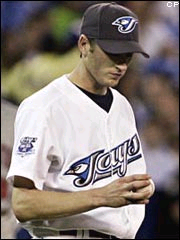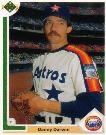The Toronto Blue Jays made two transactions after
Wednesday’s game that are destined to be referenced
anytime a baseball writer uses the phrase “addition by subtraction.” Josh
Towers (1-8 9.00) and
Russ Adams (.258 2 16) were both sent down to AAA Syracuse. The Blue Jays immediately become the
favorites to win the AL East. The
biggest question right now is, “What took them so long?”
 | |
| The problem's not with the ball, Josh | |
Lots of pitchers start off with shaky Aprils and rebound to
have fine seasons, but there was no reason to believe that Josh Towers
was such a pitcher. I can understand
sticking by a first round draft pick. I
can understand standing behind a guy who’s throwing 98 MPH. I have no problem with continually starting
an ineffective pitcher with a curveball that breaks from ear to knee. But Josh Towers
was a 15th round pick by the Baltimore Orioles whose fastball topped
out at 91 MPH. Worse yet, his slider had
so little movement that you’d swear it was a changeup, and his changeup never
varied as much as 10 MPH from his best fastball. His stuff was nonexistent; Towers survived
through pinpoint control of all of his pitches, and once that command deserted
him, he became more hittable than Jose Lima.
How
much better off are the Blue Jays without Towers? They went 1-9 in games that he started,
meaning that they have a 24-12 (.667) record in non-Towers games. But more than that, Towers has only averaged
4.5 innings per start this year. That
means that the Blue Jay bullpen has had to pitch nearly as many innings as
Towers did during his starts. A tired,
overworked bullpen may have cost Toronto
games in which Towers did not even start.
They’re just lucky that über-ace Roy Halladay
averages over seven innings per start.
 | |
| Is this the longest throw that Russ can handle? | |
As
for Russ Adams, his inability to make a standard throw to first base has been
compared to that of Steve Sax and Chuck Knoblauch. His 10 errors at shortstop are surpassed only
by Carlos Guillen, who still has a better fielding
percentage than Adams by 18 points. But it’s quite likely that Adams’
throwing problems were physical more than mental, since he’s never had the arm
to play shortstop. Among 2005
shortstops, The
Fielding Bible ranks Adams 29/32 in their
plus/minus system, 20/32 in percentage of double plays turned, and 31/32 in
relative range factor. The fact that he
was slightly better at the shorter throws needed in double plays further
highlights his arm problems. Therefore
he’s going to spend some time at second base for Syracuse.
But
it may be that his future role is as a backup infielder. You see, Adams
has never hit well, either. He hasn’t
posted an OPS over .768 at any minor league level
since low-A ball, and has a major league OPS of .722. Unfortunately, while replacements Aaron Hill
and John McDonald are solid and excellent defensively, neither promises to
bring much more punch to the plate (Hill has shown some promise in that tregard, McDonald none).
Worse yet, the organization lacks a middle
infielder with even a .650 OPS at the double or triple-A levels. Maybe they could make a play for one of the
six lackluster second basemen on the Cubs’ 25-man roster (that’s not hyperbole;
count them), but it’s hard to imagine that they’ll come up with someone who’s
more of a liability than Adams.
In
other AL East news, the Red Sox recalled reliever Jermaine
Van Buren from Pawtucket
to replace the injured/ineffective Teenage Mutant Ninja Turtle L. DiNardo. The Yankees
acquired Erubiel Durazo and
Nick Green for their minor leagues and activated Gary Sheffield from the DL
despite his broken hand. While these are
indeed positive transactions, they’re a long way from the net gain that the
Blue Jays experienced Wednesday night. Boston and New
York are going to need to make some blockbuster moves
to keep pace with their Canadian adversaries.






 Tired of defensive stats that are misleading, arbitrary, and compicated?
Tired of defensive stats that are misleading, arbitrary, and compicated?